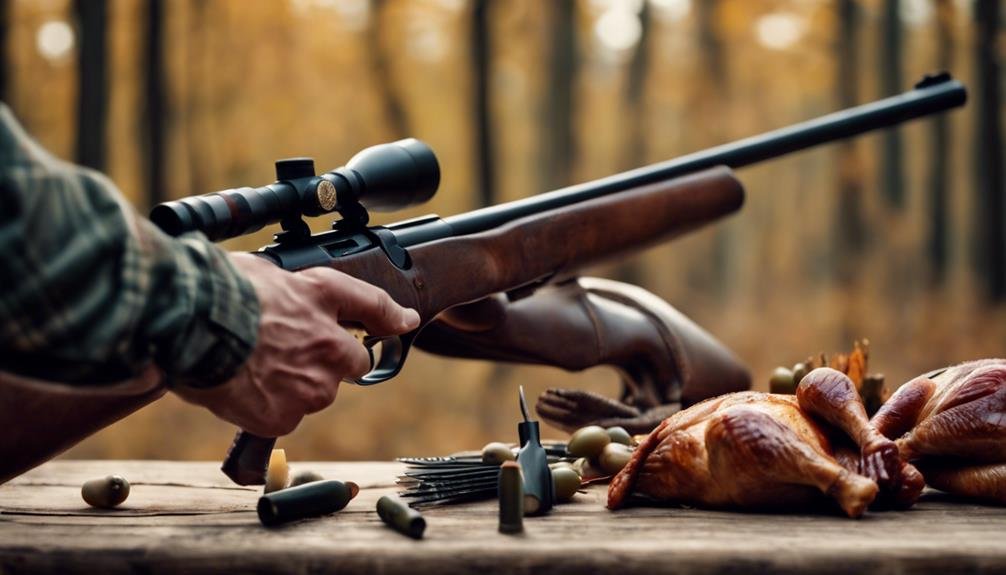When it comes to taking down a turkey, selecting the perfect load is vital. Modern turkey hunting has evolved substantially, with advancements in copper-plated lead pellets and tungsten shot enhancing performance and range. To increase killing power and range, copper-coated lead pellets penetrate deeper into flesh and bone. However, fine-tuning your shotgun is imperative to guarantee a tight and consistent shot pattern. By refining your shotgun and choosing the right load, you'll be well on your way to a successful and humane harvest. As you refine your approach, you'll uncover the secrets to a perfect turkey takedown.
Key Takeaways
- Copper-coated lead pellets provide better penetration and a larger lethal range, increasing the chances of a successful hunt.
- Modern turkey loads offer a variety of configurations, including specialized super-full turkey chokes, to suit specific hunting needs.
- Pattern density and range are affected by shotgun patterning, choke selection, and gun fitment, making patterning a crucial step.
- Testing different turkey loads and chokes helps fine-tune the shotgun for a lethal pattern at various distances.
- Copper-coated lead pellets are a more environmentally friendly option, reducing the risk of lead contamination in the environment.
Evolution of Turkey Loads
Over the years, turkey hunters have witnessed a substantial evolution in turkey loads, shifting from the traditional 2-inch, #6 lead, 12-gauge field loads to modern configurations that boast bigger payloads and faster speeds. This historical development has led to load innovations, revolutionizing the sport. The introduction of copper-plated lead pellets and tungsten shot has markedly enhanced performance, providing more killing power and range. Today, hunters can choose from a variety of loads tailored to their specific needs, including specialized super-full turkey chokes that constrict pellet loads into tighter patterns. This evolution has not only improved hunting success but also expanded the range of turkey hunting, making it more accessible and enjoyable for enthusiasts.
Copper-Coated Lead Performance
Copper-coated lead pellets have proven to penetrate further into flesh and bone, substantially extending the lethal range of turkey hunters. This copper performance enhancement guarantees a more effective and humane harvest. Copper-coated lead pellets offer a significant advantage over traditional lead shot, making them an attractive option for turkey hunters. As a lead alternative, copper-coated pellets provide better penetration and a larger lethal range, increasing the chances of a successful hunt. Additionally, copper-coated lead pellets are a more environmentally friendly option, reducing the risk of lead contamination in the environment. Overall, copper-coated lead pellets offer a reliable and effective solution for turkey hunters seeking a reliable and humane harvest.
Shotgun Patterning Essentials
Patterning a shotgun is a crucial step in preparing for a successful turkey hunt, as it verifies the gun is shooting where aimed, increasing the chances of a clean and humane harvest. To confirm peak performance, consider the following patterning essentials:
| Factor | Description | Impact on Pattern |
|---|---|---|
| Pattern Density | Distribution of pellets in the pattern | Affects killing power and range |
| Shot Stringing | Spread of pellets in the pattern | Influences pattern density and range |
| Gun Fitment | How the gun fits the hunter | Impacts sight alignment and accuracy |
| Choke Selection | Choice of choke constriction | Affects pattern density and range |
Patterning for Turkey Hunting Success
As the turkey hunting season approaches, a well-patterned shotgun becomes an essential tool for a successful and ethical hunt. Patterning your shotgun is vital to guarantee a tight and consistent shot pattern, increasing your chances of a clean kill. By testing different turkey loads and chokes, you can fine-tune your shotgun to deliver a lethal pattern at various distances. Effective turkey tactics rely on a well-patterned shotgun, allowing you to make the most of your hunting strategies. A shotgun that patterns well will help you adapt to different hunting scenarios, from close-quarters shots to longer ranges. By taking the time to pattern your shotgun, you'll be better equipped to take down that gobbler with confidence.
Turkey Population Management
Wild turkey populations, which are estimated to be around 7 million in North America, require careful management to maintain a healthy balance and guarantee sustainable hunting. Effective population management involves understanding population dynamics, including factors such as habitat quality, food availability, and predation. Harvest strategies play a vital role in regulating turkey populations, as they help maintain a balance between population growth and habitat capacity. By implementing adaptive harvest strategies, wildlife managers can guarantee that turkey populations remain healthy and sustainable, while also providing opportunities for hunters. By balancing population growth with harvest rates, we can maintain a thriving turkey population for generations to come.
Conservation Efforts and Habitat
Five primary habitat types – forests, grasslands, shrublands, agricultural areas, and urban landscapes – provide the foundation for conservation efforts focused on preserving and enhancing wild turkey habitats. These diverse habitats support the complex needs of wild turkeys, from nesting and foraging to roosting and breeding. Conservation efforts prioritize preserving and restoring habitats, creating wildlife corridors to connect fragmented habitats, and promoting sustainable land-use practices. Forest restoration, in particular, is vital, as it helps maintain healthy forests that provide critical habitat for turkeys. By protecting and enhancing habitats, conservationists can safeguard the long-term sustainability of wild turkey populations, supporting healthy ecosystems and thriving wildlife populations.
Identifying Turkey Subspecies
With their distinctive physical characteristics and regional distributions, the five subspecies of wild turkey in North America can be identified through a combination of visual cues and geographic location.
Here are three key factors to help you identify turkey subspecies:
- Plumage patterns: Each subspecies has unique feather patterns, colors, and sheen. The Eastern Wild Turkey, for example, has a bronze-like sheen, while the Rio Grande Wild Turkey has a more copper-like tone.
- Beak color: The beak color can also be an identifying feature. The Osceola Wild Turkey, found only in Florida, has a bright red beak, whereas the Merriam's Wild Turkey has a pinkish-gray beak.
- Tail feathers: The shape, length, and color of tail feathers can also help identify a subspecies. The Gould's Wild Turkey, found in the southwestern United States, has long, slender tail feathers with a distinctive white tip.
Turkey Distribution and Habitat
Across North America, the distribution of wild turkeys spans a vast range of habitats, from dense forests to open grasslands and agricultural areas. Understanding the nuances of turkey habitats is essential for effective hunting. Forest fragmentation, where forests are broken up into smaller patches, can affect local turkey populations. Habitat corridors, connecting isolated habitats, become vital for turkey movement and genetic exchange.
| Habitat Type | Turkey Population | Habitat Characteristics |
|---|---|---|
| Forests | High | Dense canopy, understory vegetation |
| Grasslands | Medium | Open spaces, scattered trees |
| Agricultural | Low | Crop fields, fragmented habitats |
State-by-State Hunting Regulations
Hunters must familiarize themselves with the specific regulations governing wild turkey hunting in their state or region, as these rules vary substantially from one jurisdiction to another. This is crucial to ensure a successful and legal hunt. In the United States, 49 states have wild turkey hunting seasons, each with its unique set of regulations. To stay compliant, hunters should:
- Obtain the required Hunting Licenses and permits from their state's Wildlife Agencies.
- Familiarize themselves with specific bag limits, season dates, and hunting hours.
- Understand any specific gear restrictions, such as shotgun gauges or shot types.
Bag Limits and Season Dates
In the United States, wild turkey hunting regulations dictate specific bag limits and season dates, which vary substantially from state to state, making it essential for hunters to stay informed about the rules governing their region. Bag limits, for instance, may range from one to four birds per hunter, depending on the state and time of year. Season dates, on the other hand, typically fall between late March and early May, with some states offering spring and fall hunting seasons. Hunting calendars and license restrictions are critical components of population management, ensuring a sustainable harvest of wild turkeys. Hunters must stay up-to-date on local regulations to avoid fines and penalties, and to contribute to the conservation of this iconic game bird.
Ethical Hunting Practices
Beyond the domain of regulatory compliance, ethical hunting practices are vital to guarantee a respectful and sustainable pursuit of wild turkeys. A respectful harvest is crucial, ensuring that the animal is treated with dignity and respect. This involves making a clean and swift kill, avoiding unnecessary suffering. Here are three key aspects of ethical hunting practices:
- Humane Dispatch: Ensure a quick and painless death, using the right equipment and technique.
- Respectful Harvest: Treat the animal with respect, avoiding unnecessary suffering and ensuring a clean kill.
- Responsible Hunting: Follow local regulations, respect the environment, and prioritize a sustainable hunting practice.
Frequently Asked Questions
What's the Ideal Shotgun Gauge for Turkey Hunting?
When selecting a shotgun for turkey hunting, the ideal gauge debate centers around 12-gauge and 20-gauge options, with 12-gauge offering more payload and range, while 20-gauge provides a tighter pattern and reduced recoil.
How Often Should I Pattern My Turkey Hunting Shotgun?
For peak performance, pattern your turkey hunting shotgun every 2-3 months or after 50-75 rounds to maintain pattern consistency, and perform regular shotgun maintenance to guarantee a successful hunt.
Can I Use a Rifle to Hunt Wild Turkeys?
In bygone eras, riflemen stalked prey with stealthy precision. Today, when it comes to hunting wild turkeys, rifle selection is vital, as these birds' acute senses and unpredictable behavior demand a precise, high-velocity shot.
What's the Best Camouflage Pattern for Turkey Hunting?
When it comes to choosing the best camouflage pattern for turkey hunting, consider the terrain and vegetation of your hunting grounds, as pattern preferences vary by region, and opt for a versatile, adaptive camouflage that evolves with the changing environment.
Can I Hunt Wild Turkeys on Private Property Without Permission?
Did you know that over 90% of American wild turkeys inhabit private lands? When hunting on private property, respect landowner rights and exercise hunting ethics by obtaining written permission, ensuring a harmonious relationship between hunters and landowners.
Conclusion
Essential understanding of turkey loads, patterning, and population management is vital for successful and sustainable hunting practices. One striking statistic: in the 1930s, only 30,000 wild turkeys remained in the United States, whereas today, there are over 7 million, a tribute to conservation efforts. By adopting informed and responsible hunting practices, hunters can contribute to the continued thriving of wild turkey populations, ensuring the sport's legacy for generations to come.









